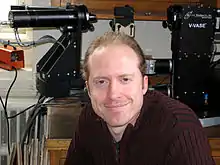Joshua Pearce
Joshua M. Pearce is an academic engineer at Western University[1] and Michigan Tech known for his work on protocrystallinity, photovoltaic technology, open-source-appropriate technology, and open-source hardware including RepRap 3D printers.
Joshua M. Pearce | |
|---|---|
 | |
| Alma mater | The Pennsylvania State University |
| Scientific career | |
| Fields | photovoltaics, open-source-appropriate technology, materials engineering, protocrystallinity, open-source hardware |
| Institutions | University of Western Ontario, Michigan Tech, Queen's University |
| Doctoral advisor | Christopher R. Wronski |
| Website | Michigan Tech Open Sustainability Technology Group |
Dr. Pearce received his Ph.D. at The Pennsylvania State University, where his work on protocrystallinity helped develop low-cost amorphous silicon solar photovoltaic technology.[2] His solar research continues.[3][4] For example, his research group published a levelized cost of electricity study[5] on solar energy showed solar electricity was economically competitive with fossil fuels over wide geographic regions.[6][7] His research into BDRF modeling[8] of reflectors showed potential solar systems output increases of 30%.[9]
However, he is also a vocal advocate of an open-source approach to technical development.[10] For his work related to open-source nanotechnology,[11] Ars Technica compared him to American software freedom activist Richard Stallman.[12] He applied open-source 3-D printing and electronics to scientific equipment design,[13] where he has claimed both superior innovation and lower costs.[14][15] Reviewing his book Open-Source Lab, 3-D Printing Industry wrote, "This is a manual that every scientist should read and it holds a message so powerful and disruptive that the Anarchist Cookbook is a fairy tale in comparison."[16]
His research has shown that printing household items with a RepRap is less costly[17] and better for the environment[18] than purchasing conventionally manufactured goods. Similarly, his group developed the recyclebot, a waste plastic extruder, which drops the cost of 3D printing filament from $35/kg to ten cents per kg while making recycling even more environmentally beneficial.[19][20]
In 2013 his group released an open-source 3D printer capable of printing in steel, which cost less than US$1,200.[21][22] in order to encourage more rapid technological development according to Scientific American.[23] This cost reduction was significant as the New York Times reported commercial metal printers at the time cost over US$500,000.[24]
He further developed inexpensive methods such as SODIS to disinfect drinking water in the developing world, using sunlight, water bottles, and salt.[25] Recently, the MIT Sloan Management Review reported that Dr. Pearce has combined many of his research areas developing solar powered 3-D printers to drive sustainable development.[26]
Bibliography
- Open-Source Lab (book):How to Build Your Own Hardware and Reduce Research Costs (2014)
- David Denkenberger and Joshua Pearce, Feeding Everyone No Matter What: Managing Food Security After Global Catastrophe, Academic Press (2015).
References
- "Western News - Bringing open-source, sustainable tech to the fore". Western News. September 9, 2021. Retrieved November 14, 2021.
- Pearce, Joshua M. (2004). "Control of Staebler-Wronski defects in hydrogenated amorphous silicon for the de". Adsabs.harvard.edu. Bibcode:2004PhDT........88P.
{{cite journal}}: Cite journal requires|journal=(help) - "Efficiency breakthrough in solar thermal cells - Cogeneration & On-Site Power Production". Cospp.com. Archived from the original on October 29, 2013. Retrieved September 5, 2013.
- Herman K. Trabish (December 7, 2011). "New Study: Solar Grid Parity Is Here Today". Greentech Media. Retrieved September 5, 2013.
- Branker, K.; Pathak, M. J. M.; Pearce, J. M. (December 1, 2011). "A review of solar photovoltaic levelized cost of electricity". Renewable and Sustainable Energy Reviews. 15 (9): 4470–4482. doi:10.1016/j.rser.2011.07.104. S2CID 73523633.
- "Cost of solar falling according to Queen's study". CTVNews. December 7, 2011. Retrieved February 26, 2016.
- "New Study: Solar Grid Parity Is Here Today". www.greentechmedia.com. Retrieved February 26, 2016.
- Andrews, R. W.; Pollard, A.; Pearce, J. M. (November 1, 2015). "Photovoltaic System Performance Enhancement With Nontracking Planar Concentrators: Experimental Results and Bidirectional Reflectance Function (BDRF)-Based Modeling". IEEE Journal of Photovoltaics. 5 (6): 1626–1635. doi:10.1109/JPHOTOV.2015.2478064. ISSN 2156-3381. S2CID 40828010.
- "Researchers Discover How to Shine More Sunlight on Solar Panels, Increase Output By 30% | IHS Electronics360". electronics360.globalspec.com. Retrieved February 26, 2016.
- Pearce, JM (September 14, 2012). "Podcast Interview". Science. Sciencemag.org. 337 (6100): 1303–4. Bibcode:2012Sci...337.1303P. doi:10.1126/science.1228183. PMID 22984059. S2CID 44722829. Retrieved September 5, 2013.
- Timmer, John (November 21, 2012). "Stallman's got company: Researcher wants nanotech patent moratorium". Ars Technica. Retrieved September 5, 2013.
- Pearce, Joshua M. (2012). "Make nanotechnology research open-source". Nature. 491 (7425): 519–521. Bibcode:2012Natur.491..519P. doi:10.1038/491519a. PMID 23172198. S2CID 4366790.
- Pearce, Joshua M. (September 14, 2012). "Building Research Equipment with Free, Open-Source Hardware". Science. 337 (6100): 1303–1304. Bibcode:2012Sci...337.1303P. doi:10.1126/science.1228183. ISSN 0036-8075. PMID 22984059. S2CID 44722829.
- "3D Printing Brings the Science Lab to Your Backyard". Popular Mechanics. September 13, 2012. Retrieved September 5, 2013.
- McMurtrie, Beth (March 29, 2013). "Lab Equipment Made With 3-D Printers Could Cut Costs by 97% - Percolator - The Chronicle of Higher Education". Chronicle.com. Retrieved September 5, 2013.
- Sher, Davide. "Prof. Pearce's "Open-Source Lab" Unleashes the Power of 3D Printed Lab Equipment". 3D Printing Industry. Archived from the original on March 6, 2016. Retrieved February 26, 2016.
- Study: At-home 3-D printing could save consumers 'thousands' - CNN, 7/31/2013
- 3D printers use less energy than traditional manufacturing - Gigaom - available http://gigaom.com/2013/10/03/3d-printers-use-less-energy-than-traditional-manufacturing/ 3/10/2013.
- Michigan Tech Prof Says You Can Save Big With Milk Jug Recycling For 3D Printing - CBS 3/5/2014
- Need 3D printer filament? Got milk? - Ars Technica
- Loose screw? 3-D printer may soon forge you a new one - NBC News
- Testing your metal- Newsweek
- "New 3-D Metal Printer is Open Source and Affordable". Scientific American.
- An Inexpensive Way to Print Out Metal Parts - The New York Times, 2013/12/10/
- Cuda, Gretchen (May 8, 2012). "Recipe For Safer Drinking Water? Add Sun, Salt And Lime : The Salt". NPR. Retrieved September 5, 2013.
- Unruh, Gregory (February 12, 2016). "The Revolution Will Be Customized (and Recycled and Solar-Powered)". MIT Sloan Management Review. Retrieved February 26, 2016.